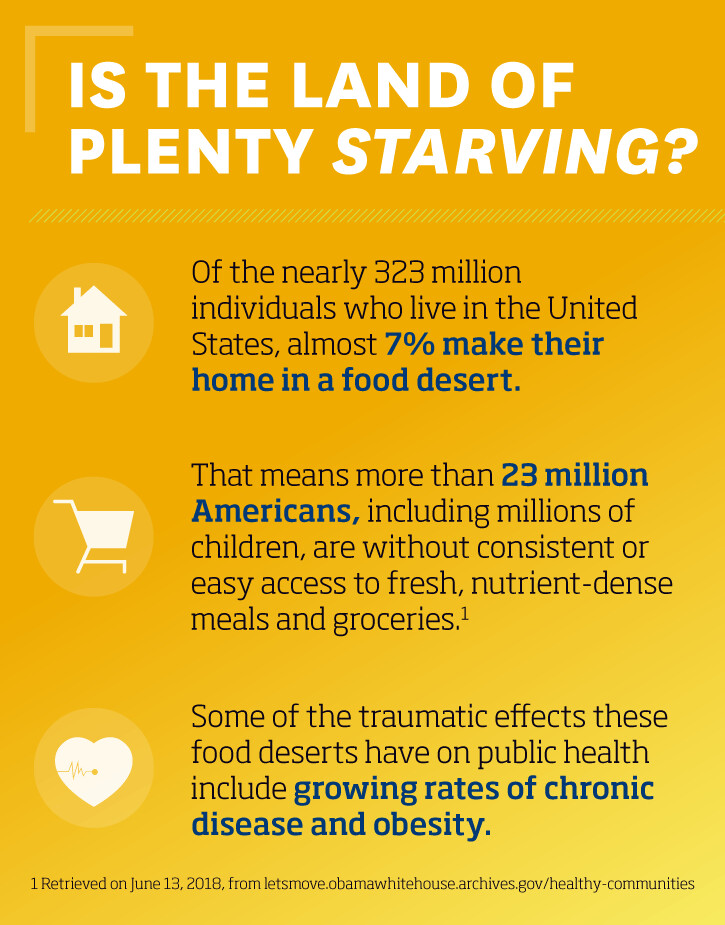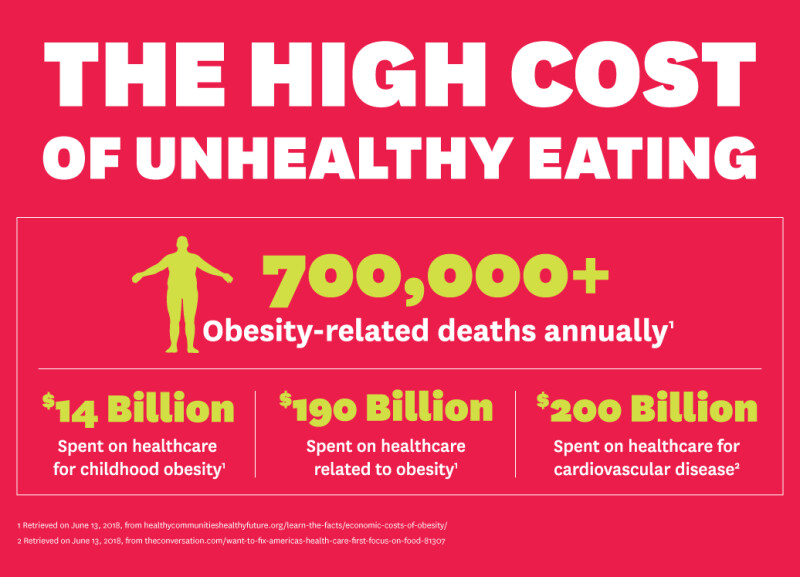Is the Land of Plenty starving?

Of the nearly 323 million individuals who live in the United States, almost seven percent make their home in a food desert. That means more than 23 million Americans, including millions of children, are without consistent or easy access to fresh, nutrient-dense meals and groceries.1 It’s an alarming trend that has accelerated with other changes in modern cities, including suburbanization, growing socioeconomic and increasingly public transportation. Some of the traumatic effects these food deserts have on public health include growing rates of chronic disease and obesity.
But what exactly is a food desert? How have they come to be so pervasive in America? And what are the most effective solutions to counteract their destructive impact?
Life in America’s Food Deserts
Defined as parts of the country that are devoid of fresh fruit, vegetables and other healthful foods2, the emergence of food deserts is often attributed to the postwar growth of suburbs and the accompanying increase in private transportation.3 In the 1950s and 1960s, suburbanization accelerated due to a host of factors, including the post-World War II housing shortage that resulted in new suburban developments, discriminatory housing policies that fostered “white flight” to the new suburbs, and American car companies’ successful lobbying against public transportation as these suburbs were built. As white upper- and middle-class Americans began to move away from city centers into more suburban, automobile-centric areas, they were quickly followed by major grocery chains. The result? An unfolding urban crisis that became rampant by the 1980s and left the low-income population that remained in major cities with rapidly declining access to quality grocery options.
Today, the U.S. Department of Agriculture (USDA) has identified at least 6,500 food desert tracts or low-access communities in the U.S., in which at least a third of the area residents are a mile or more from a major supermarket (or in rural areas, more than 10 miles from one).2 The Department of Agriculture has produced an interactive map allowing users to track the evolution of these regions over a five-year period and observe which areas of the country are most threatened by them.
But the negative impacts of this geographical trend extend beyond hunger—also known as food insecurity1—because this issue is larger than a single meal. Food deserts greatly impact the health and cumulative quality of life for a significant portion of Americans. They also contribute to growing—and costly—health disparities between urban residents from different racial groups and income levels.
Recognizing a Food Desert’s Impact on Public Health
For low-income individuals who find themselves residing in a food desert, the primary sources of sustenance are often fast-food restaurants or nearby corner stores, where the available options are inexpensive and easy to obtain but almost always high in sugar, fat and salt.
Unfortunately, diets that consist largely or entirely of these processed foods offer little nutritional density or dietary benefit and often result in higher rates of obesity and chronic diseases, including diabetes and heart disease.4 The ubiquity of such life-threatening conditions leads in turn to shorter lifespans on average throughout America’s food deserts, and it also carries a high price tag for the surrounding community and local healthcare system.
According to the USDA, up to $71 billion is spent annually to treat chronic diseases that could be managed or alleviated entirely by a healthy diet. In the case of food desert communities, residents dealing with these diseases often cannot afford treatment and those costs end up being absorbed by the local system.5

Is It Possible to Eliminate Food Deserts?
Farmers, entrepreneurs, community leaders, food policy groups, and representatives of state and federal governments have long explored possible solutions to America’s food desert crisis.
Federally, legislation like the Healthy Food Financing Initiative (HFFI) has contributed to a national effort to build and equip food retailers, including grocery stores, convenience marts and farmer’s markets, that provide healthy food and groceries to underserved areas. Between 2011 and 2016, HFFI provided more than $51.8 million in funding to these efforts.6
Elsewhere, entrepreneurial minds and local policy changes have led to the creation of mobile grocery stores, community-supported agriculture (CSA) deliveries7 and affordable ready-to-eat meals that offer a healthy alternative to fast food.8 In Chester, Pennsylvania, one enterprising community leader created the nation’s first nonprofit grocery store, which carries stock that emphasizes healthy options, offers targeted discounts, and accepts public assistance programs like SNAP and WIC.9 Many farmers markets in cities across the U.S. also accept public assistance programs.
Looking Toward a Future of Food Oases
Research today regarding the overall impact of current food desert solutions is limited because efforts to curb their effects are relatively young. Still, federal acknowledgement of this traumatic and widespread issue and community efforts to alleviate it are important. In addition to offering grocery store and restaurant solutions, local groups like the Expanded Food and Nutrition Education Program (EFNEP) in Baltimore teach food desert residents how to shop on a budget and uncover their most accessible options for nutrition and support.10 Every effort, no matter how seemingly small, contributes to alleviating this critical health crisis.
Explore the vast importance of understanding public health and its global impact, and consider how an online Master of Public Health could help you lead new conversations about how to transform America’s food deserts into food oases.
- Retrieved on June 13, 2018, from letsmove.obamawhitehouse.archives.gov/healthy-communities
- Retrieved on June 13, 2018, from americannutritionassociation.org/newsletter/usda-defines-food-deserts
- Retrieved on June 13, 2018, from ncbi.nlm.nih.gov/pmc/articles/PMC2516593/
- Retrieved on June 13, 2018, from huffingtonpost.com/entry/world-population-day-addr_b_7756372.html
- Retrieved on June 13, 2018, from ncbi.nlm.nih.gov/pmc/articles/PMC3489133/
- Retrieved on June 13, 2018, from acf.hhs.gov/ocs/programs/community-economic-development/healthy-food-financing
- Retrieved on June 13, 2018, from huffingtonpost.com/entry/mobile-grocery-store-food-desert-new-mexico_us_56426320e4b050814acef74f
- Retrieved on June 13, 2018, from kcet.org/food-living/how-everytables-restaurant-model-might-be-a-solution-for-food-deserts
- Retrieved on June 13, 2018, from npr.org/sections/thesalt/2016/07/06/484819718/a-nonprofit-grocer-tries-to-sell-healthier-food-without-going-under
- Retrieved on June 13, 2018, from hippocratesmedreview.org/an-evaluation-of-food-desert-solutions/
